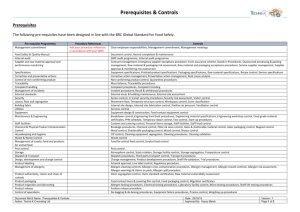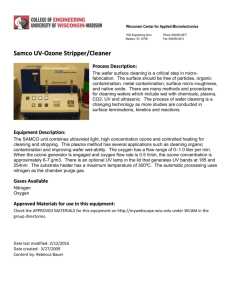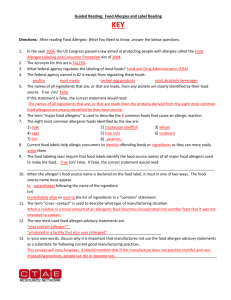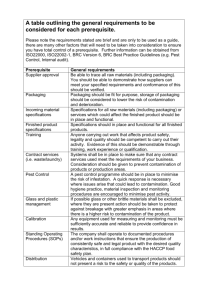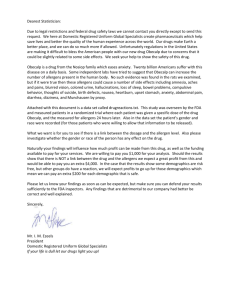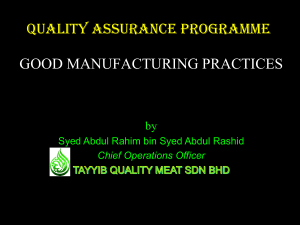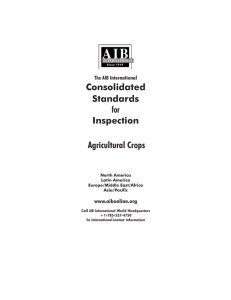Prerequisite Programs
advertisement
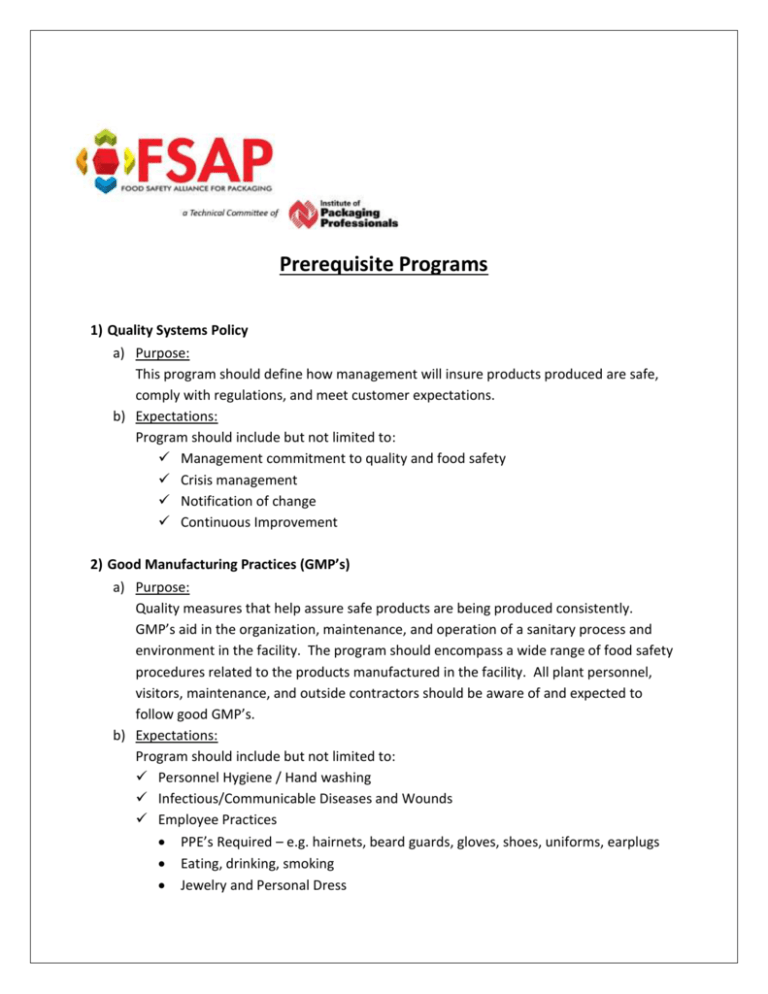
Prerequisite Programs 1) Quality Systems Policy a) Purpose: This program should define how management will insure products produced are safe, comply with regulations, and meet customer expectations. b) Expectations: Program should include but not limited to: Management commitment to quality and food safety Crisis management Notification of change Continuous Improvement 2) Good Manufacturing Practices (GMP’s) a) Purpose: Quality measures that help assure safe products are being produced consistently. GMP’s aid in the organization, maintenance, and operation of a sanitary process and environment in the facility. The program should encompass a wide range of food safety procedures related to the products manufactured in the facility. All plant personnel, visitors, maintenance, and outside contractors should be aware of and expected to follow good GMP’s. b) Expectations: Program should include but not limited to: Personnel Hygiene / Hand washing Infectious/Communicable Diseases and Wounds Employee Practices PPE’s Required – e.g. hairnets, beard guards, gloves, shoes, uniforms, earplugs Eating, drinking, smoking Jewelry and Personal Dress Facilities and Grounds Expectations Storage of Personal and Food Items Locker Rooms Daily Housekeeping/Cleaning to minimize contamination c) Examples/Supporting Documentation: Additional information can be found: U.S Code of Federal Regulations 21CFR 110 http://www.accessdata.fda.gov/scripts/cdrh/cfdocs/cfcfr/cfrsearch.cfm?cfrpart=110 3) Food Safety & Quality Systems a) Purpose: The goal of this program is to ensure raw materials and finished products meet all local and federal food safety regulations as well as specification. b) Expectations: Program should include but not limited to: An assigned person/position responsible for maintaining program Certificate of Analysis (COA) or Certificate of Conformance (COC) Facility should not allow chemicals, raw materials, or label material to be used in the process without being accompanied by a guarantee that specification is met A procedure addressing materials receipt and missing documentation (e.g. how to obtain the documentation, what to do with materials prior to receipt of COA, responsibilities and expectations of suppliers) Letters of Guarantee (LOG) An assurance letter shall be supplied stating that finished product meets regulatory compliance for specified packaging material Other guarantees (e.g. heavy metals compliance, Proposition 65, etc.) c) Examples/Supporting Documentation: Additional information can be found: Code of Federal Regulations (CFR) Citations for Color Additives, Food Ingredients & Packaging http://www.fda.gov/Food/GuidanceComplianceRegulatoryInformation/GuidanceDocum ents/FoodIngredientsandPackaging/ucm082463.htm Food ingredients and packaging guidance for industry http://www.fda.gov/Food/GuidanceComplianceRegulatoryInformation/Guidanc eDocuments/FoodIngredientsandPackaging/default.htm Proposition 65 - http://oehha.ca.gov/prop65.html Heavy metals guarantee - http://www.toxicsinpackaging.org/ 4) Traceability & Recall a) Purpose: The goal of this program is to protect the customer from the possible event of a product safety failure by removing all suspect products from the distribution channels in the least amount of time, once a product recall or withdrawal is warranted and initiated b) Expectations: Program should include but not limited to: An assigned person/position responsible for managing the program Mock recall should be performed (forwards to the customer and backwards to the raw materials) at least annually in which lot traceability is maintained Mock recall should include the following items: Scope/Summary of the recall – e.g. what was the product, lot information, time, % recovery, was the recall successful and meet expectations Inventory/shipment and processing records Recall and notification procedures including contact information Action plans Product disposition and guidelines Hold area procedures Contact information for customers and regulatory agencies 5) Pest Control Program a) Purpose: The goal of the pest control program is to exclude pests from the plant (e.g. rodents, insects, and birds). The program is carried out through a licensed company which meets all Federal, State, and Local regulatory requirements or by a licensed employee. The pest control program assists the plant in maintaining a pest-free environment. b) Expectations: Program should include but not limited to: An assigned person/position responsible for managing the program Pest Control Policy Licensed & Insured Pest Control Company (unless handled internally) with current records available Internal/External device monitoring logs with trend charts Register of approved chemicals/bait that include: Name of chemical and area of application MSDS’s and sample labels Pesticides should be stored off site Internal verification of contractor Food Safety/GMP training for the PCO 6) Documentation & Record Control a) Purpose: The document control program ensures current and accurate information is distributed via documentation throughout the plant. A document control policy shall be in place and audited. b) Expectations: Program should include but not limited to: Document retention times shall be defined Documentation shall be adequately secured to reduce the risk of tampering Good record keeping practices shall be followed Ensure records are adequate to confirm conformance to specified standards and to demonstrate the quality system is effective 7) Allergen Awareness/Management Program a) Purpose: The allergen control program ensures facility has evaluated processes and facility to mitigate any risk of allergen related food safety incidents. b) Expectations: An assigned person/position responsible for managing the program Program shall include annual employee training on allergen awareness as well as on specific areas based on the type of material being produced Program should consider 3 areas of allergen uses in the plant: 1. Packaging printing/artwork control (prevent potential mislabeling of foods) Verification that print copy matches customer proof copy Layout of copy to prevent potential for materials to be mixed after printing/cutting/stacking Control of printing plates, cylinders, and blankets to prevent use of obsolete or incorrect media Control of materials within the manufacturing process to prevent mixing of materials within a box, roll, skid, pallet, etc 2. Raw materials/processing aids that contain allergens (e.g. wheat, soy) Evaluation should be completed yearly or any time a new material is introduced to the process to determine any allergens are present in raw materials and processing aids If allergens are present appropriate cleaning/sanitizing steps must be taken along with appropriate testing/verification 3. Allergen presence in the facility Evaluation should be completed to determine if any allergens are present in vending machines, employee lunches, etc. c) Examples/Supporting Documentation: Additional information can be found: Food Allergy Research & Resource Program http://www.farrp.org 8) Foreign Material & Defect Control a) Purpose: Designed to ensure facility minimizes any foreign or extraneous material contamination b) Expectations: Program should include but not limited to: Glass / Brittle Plastics / Ceramics Control Program – Register of all glass, brittle plastics, and ceramics in production areas Register should be audited on predetermined basis (should be based on risk) – e.g. computer monitors, lab equipment, structural glass, gauges, lights, doors, alarms, fork truck lights, etc.) Items should be replaced with shatterproof versions if available Clean up / Product Isolation Procedure Other process controls should be considered based on feasibility Vision systems Metal detectors 9) Process Control a) Purpose: All employees are part of facilitating a quality assurance program to ensure 100% compliance to the company and customer standards b) Expectations: Program should include but not limited to: An assigned person/position responsible for managing the program Testing and quality checks at pre-determined frequencies Use of statistical process control to determine capabilities Equipment calibration program Employee training program Quality documentation completed and reviewed by quality or operations personnel 10) Line Clearance a) Purpose: To minimize the potential of product mix, all labels, packing material, documentation, and previous products run shall be removed from the machine and surrounding area prior to brining materials for the next job to the work area b) Expectations: Program should include but not limited to: An assigned person/position responsible for managing the program Line clearance shall be documented and a secondary inspection is recommended Line clearance records shall be retained following existing company policy 11) Cleaning / Sanitation a) Purpose: This program will vary based upon the products and processes at the facility. The goal of the program is to maintain a sanitary/clean environment necessary for the production of food packaging of the highest quality and safety. b) Expectations: Program should include but not limited to: An assigned person/position responsible for managing the program Detailed cleaning/sanitizing instructions for each piece of equipment or area. Instructions should include chemicals used and concentrations. An approved cleaning/sanitizing chemical list and areas/equipment used Cleaning schedule that defines frequency of each piece of equipment / area 12) Preventative Maintenance a) Purpose: This program is designed to inspect and prepare equipment to ensure precise performance. b) Expectations: Program should include but not limited to: An assigned person/position responsible for managing the program Tracking of equipment undergoing maintenance and temporary repairs Preventative maintenance schedule with frequencies and verification A tools and parts control/reconciliation program Preventive maintenance instructions should include a cleaning/sanitation step and/or inspection procedures before machine is put back into production All PM’s should be documented 13) Food Defense/Plant Security a) Purpose: The facility shall have systems in place to ensure the security of the workplace and that products have not been adulterated or misbranded b) Expectations: Program should include but not limited to: An assigned person/position responsible for managing the program Security audits shall occur at least yearly or if major changes have occurred to building and equipment Obsolete/unused printed packaging materials shall be disposed of properly (e.g. defaced, destroyed, shredded, etc.) c) Examples/Supporting Documentation: Additional information can be found: C-TPAT Program http://www.ctpat.com/documents/ctpat_strategicplan.pdf Examples of security assessments: 14) Corrective Action System/Customer Complaints a) Purpose: The goal is to resolve all customer complaints quickly, completely, and to the satisfaction of the customer and the plant. b) Expectations: Program should include but not limited to: An assigned person/position responsible for managing the program Customer complaint procedure Identification of food safety versus quality issue Root cause analysis Follow-up & corrective action plan Response to the customer Disposition of product 15) Chemical Control Program a) Purpose: The goal of this program is to eliminate the possibility of contamination of food contact surfaces and finished products with non food grade substances. This program also protects employees and the production area from exposure to hazardous chemicals by managing the purchase, receiving, storage, mixing, labeling and use of all chemicals in the plant. b) Expectations: Program should include but not limited to: An assigned person/position responsible for managing the program An approved chemical list with intended uses Chemical storage areas should be segregated and controlled Training Hazardous Communication / Emergency Procedures MSDS Facility should maintain a MSDS program and not allow chemicals to enter facility unless approved and accompanied by material safety data sheet MSDS’s should be available to all employees 16) Internal Audits a) Purpose: The facility shall follow a strict documented self-auditing program of quality and food safety programs, which involves the participation of all managers to be audit ready and in compliance. b) Expectations: Program should include but not limited to: An assigned person/position responsible for managing the program A written procedure and audit check sheet The audit frequency A written report and documented corrective actions Key performance indicators for the plant 17) Microbiological Control Program a) Purpose: To ensure the risk of microbiological contamination is evaluated and controlled. Micro testing requirements will vary based upon products, processes, government, and industry requirements. b) Expectations: Program should include but not limited to: An assigned person/position responsible for managing the program Documentation from municipality or lab indicating water in facility is potable If facility uses water-based processing aids (e.g. mandrel lubricants), measures should be taken and documented to ensure micro contamination is not present. Verification is recommended by an outside laboratory.

